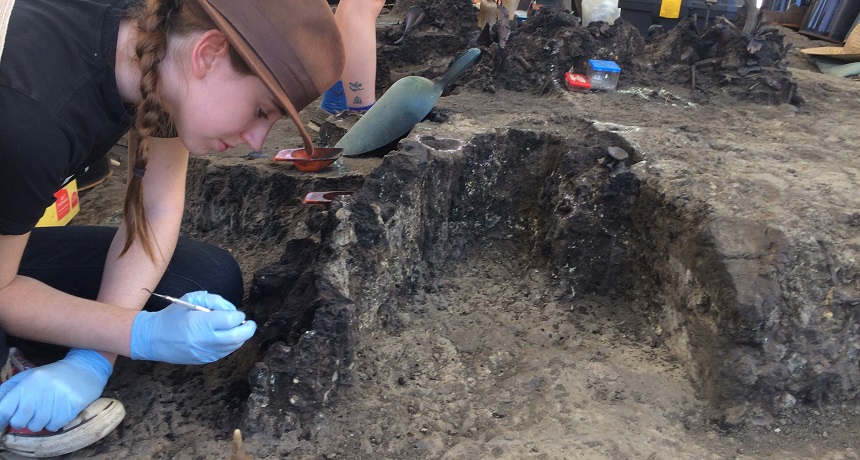Unearth fossil love as a tar pit volunteer
A Los Angeles museum allows tweens and teens to help study its tar pits

Cynthia Egan, an adult volunteer, carefully removes tar from bird bones and preserved plants at the La Brea Tar Pits.
B. Brookshire/SSP
Share this:
- Share via email (Opens in new window) Email
- Click to share on Facebook (Opens in new window) Facebook
- Click to share on X (Opens in new window) X
- Click to share on Pinterest (Opens in new window) Pinterest
- Click to share on Reddit (Opens in new window) Reddit
- Share to Google Classroom (Opens in new window) Google Classroom
- Click to print (Opens in new window) Print
LOS ANGELES – An ancient skeleton is always a fascinating sight. At the La Brea Tar Pits in Los Angeles, Calif., you can get up close and personal with skeletons of mammoths, dire wolves, sabercats and so much more. Such animals, which thrived here thousands of years ago, are now extinct. If you love ancient life, you might be able to get your hands on one or more of these fossils. How? Become a museum volunteer.
The tar pits are actually filled with asphalt, a sticky form of crude oil. This dark goo bubbles slowly to the surface. There it creates thick, sticky patches — in some cases, puddles and ponds — across the landscape. The tar pits at La Brea have been simmering for more than 50,000 years.
Over time, some of these tarry spots became covered with water. When animals waded in for drink, they would have quickly gotten stuck. Unable to escape, they’d die, their bones forever trapped by the tarry goo. Scientists have been excavating skeletons from the asphalt at La Brea for MORE THAN 100 years. They use them to learn about life in southern California long ago and how it compares to wildlife in and around the area today.
Volunteers teach others about the amazing fossil finds, and the animals that would have left them. And if you have the patience to work very slowly and carefully ‘behind the scenes’ at this museum, you might one day get to proudly point to one on display, and say “I dug up that one.”
The Page Museum allows students 16 and older to work as youth volunteers at the La Brea Tar Pits and its building, where the best tar pit fossils sit on display. Students 11 to 15 can help out too, as part of a youth-and-parent team (which means that a parent also has to participate).
Youth volunteers and family teams both take part welcoming visitors at the museum’s entrance. Some also lead educational activities for adults and kids. High school students help with summer day camp programs at the nearby Natural History Museum.
Anyone 16 or older can also volunteer to work behind the scenes. With toothbrushes, soaps and tiny tools, volunteers help clean the many fossils still coated in dirt and tar. Such volunteers must commit to work for at least three months and show up at least one full day per week. This is hard and very detailed work. Volunteers need to pay very close attention the delicate bones, plants and bugs they work with.
But the payoff can be high. A good volunteer can graduate up through the ranks to join the excavation team, experienced fossil diggers who extract bones directly from huge blocks of hardened tar. It’s valuable experience if you want to become a paleontologist, someone who studies ancient plants and animals.
So if you’re near Los Angeles and driven to find out more about animals and plants from years past. check out the volunteer site and fill out an application. You could share your love of fossils with hundreds of museum visitors, and maybe turn up a few new specimens.
Follow Eureka! Lab on Twitter
Power Words
extinct An adjective that describes a species for which there are no living members.
extinction The state or process of a species, family or larger group of organisms ceasing to exist.
fossil Any preserved remains or traces of ancient life. There are many different types of fossils: The bones and other body parts of dinosaurs are called “body fossils.” Things like footprints are called “trace fossils.” Even specimens of dinosaur poop are fossils.
paleontologist A scientist who specializes in studying fossils, the remains of ancient organisms.
paleontology The branch of science concerned with ancient, fossilized animals and plants.